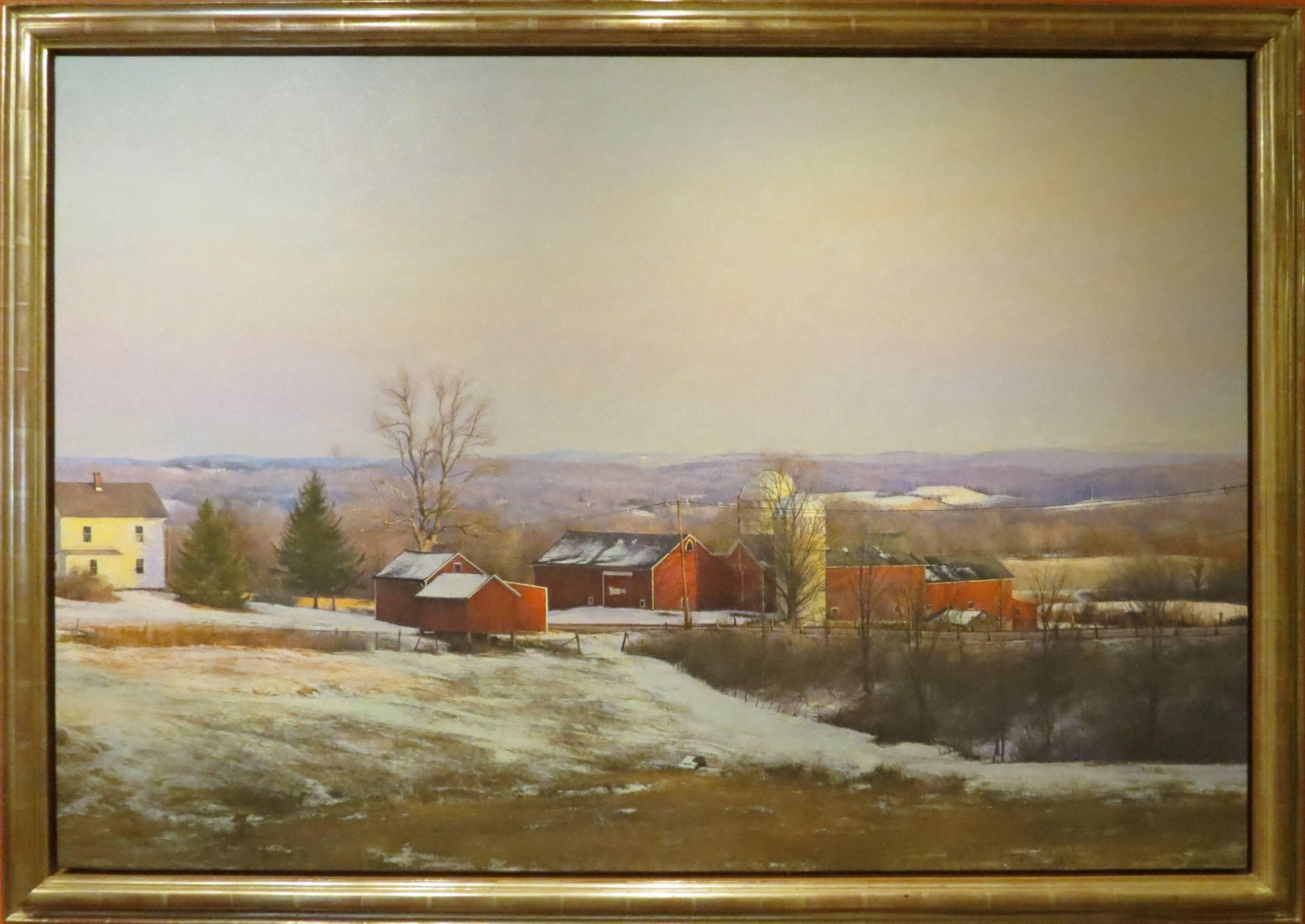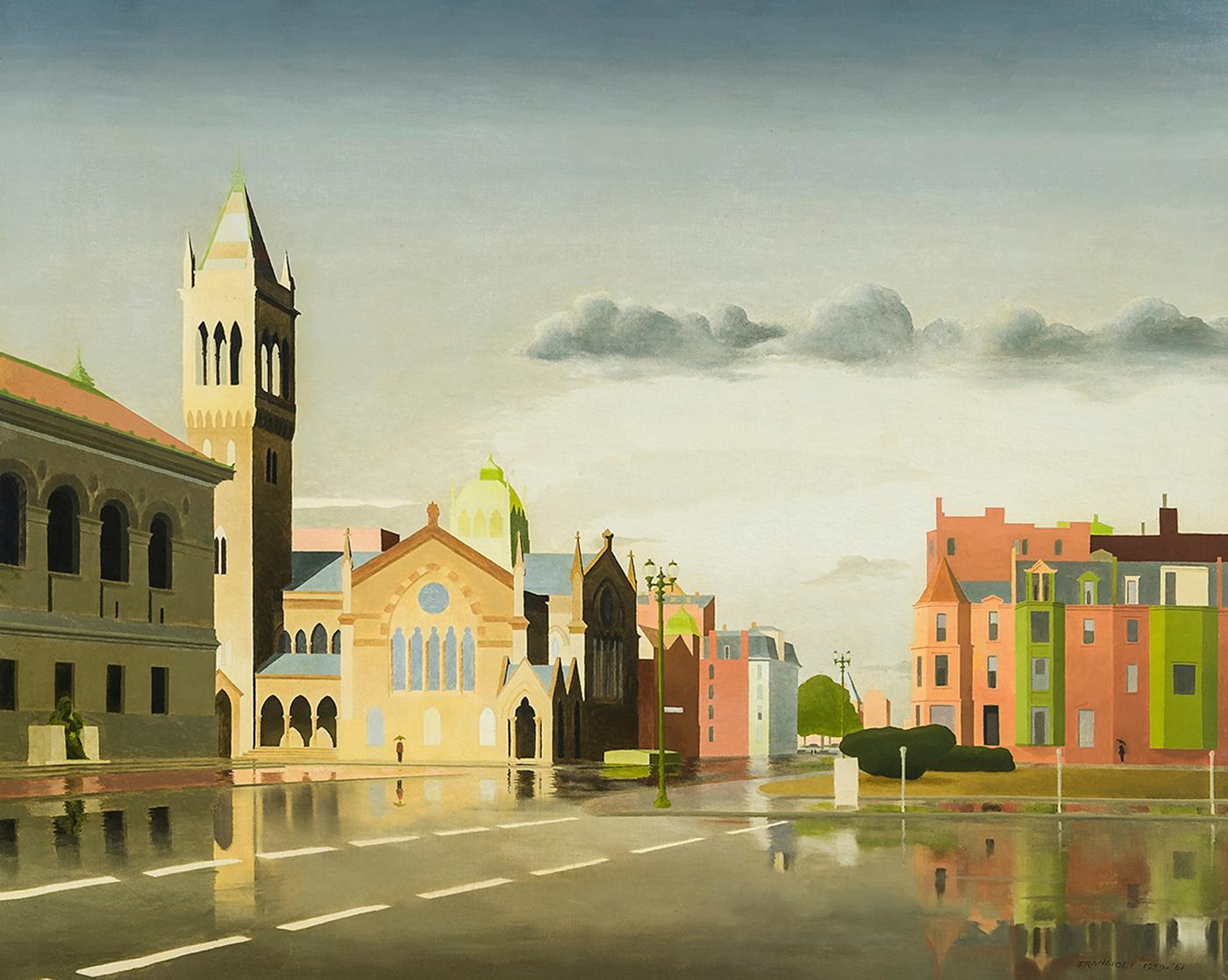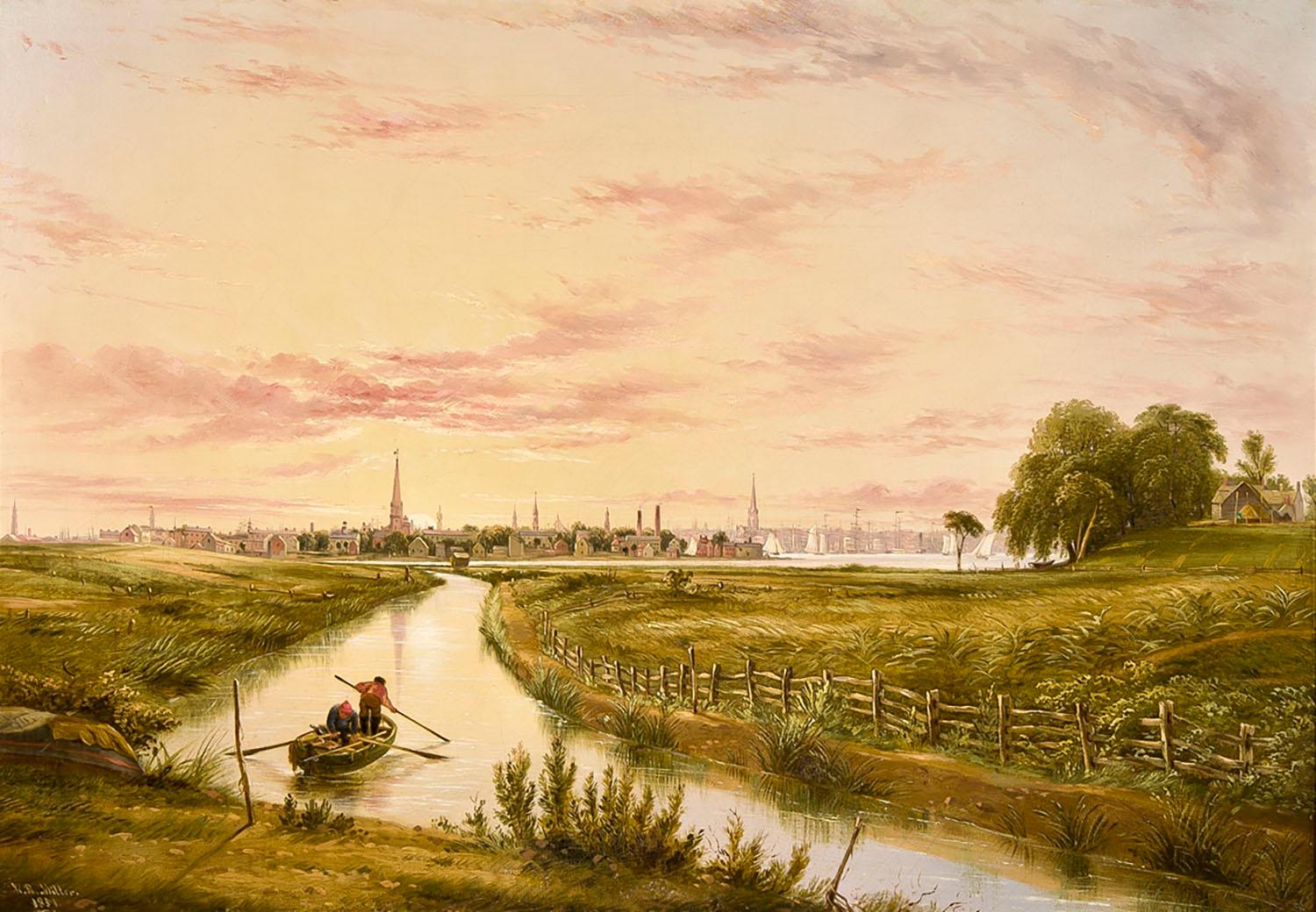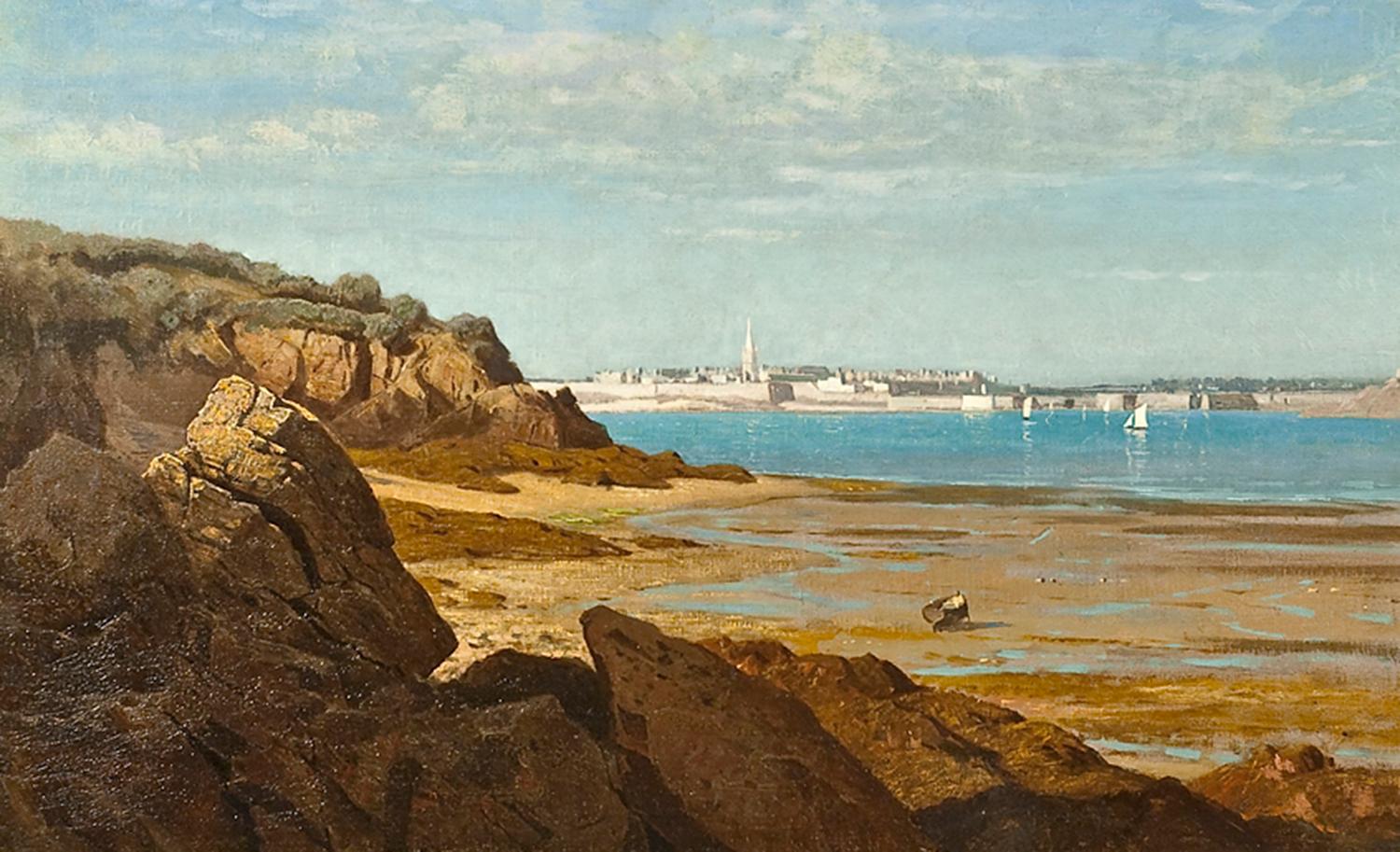Items Similar to THE FERRY
Want more images or videos?
Request additional images or videos from the seller
1 of 6
John R. GrabachTHE FERRY
About the Item
Grabach, John R. (American 1886-1981) THE FERRY. Oil on panel, not dated. Signed within the image, lower right, and also on the back of the panel. 5 1/2 x 8 3/4 inches, 140 x 122 mm. In very good condition, framed. John R. Grabach spent his early life in Newark, NJ. Beginning in 1904, he took night classes at the Art Students League in New York City, commuting from Newark, where he also worked in a silver manufacturing company. Among his teachers were Kenyon Cox and George Bridgman. He later became an educator, silver designer and also designed postage stamps for the US Government, but his career was primarily as a painter. He took his subject matter primarily from the urban landscape of New York and New Jersey, and he is most often grouped with the Social Realist school of artists. We have not located the scene of The Ferry with specificity, but given the presence of industrial buildings and machinery in the background, it seems likely that it is an industrial port area in New York or New Jersey.
- Creator:John R. Grabach (1886 - 1981, American)
- Dimensions:Height: 9 in (22.86 cm)Width: 12 in (30.48 cm)Depth: 2 in (5.08 cm)
- Medium:
- Movement & Style:
- Period:
- Condition:
- Gallery Location:Portland, ME
- Reference Number:
About the Seller
5.0
Recognized Seller
These prestigious sellers are industry leaders and represent the highest echelon for item quality and design.
Platinum Seller
These expertly vetted sellers are 1stDibs' most experienced sellers and are rated highest by our customers.
Established in 1966
1stDibs seller since 2016
297 sales on 1stDibs
Typical response time: 2 hours
Associations
International Fine Print Dealers Association
- ShippingRetrieving quote...Ships From: Portland, ME
- Return PolicyA return for this item may be initiated within 10 days of delivery.
More From This SellerView All
- ROCKPORT, MAINELocated in Portland, MESherry, William Grant (American, 1914-2003). ROCKPORT, MAINE, 1960. Oil on Canvas, signed lower right, and also signed, titled, dated, and inscribed on the verso "To my friends Shirl...Category
1960s Landscape Paintings
MaterialsOil
- COREA SPRINGBy George KunkelLocated in Portland, MEKunkel, George (American 1922-1984). COREA SPRING. Acrylic on torn and collaged papers. Signed. 15 9/16 x 23 1/2 inches, framed to 16 1/4 x 24 1/4 inches inches. With Kunkel's label ...Category
Mid-20th Century Landscape Paintings
MaterialsAcrylic
- SEATED MANBy Isabel BishopLocated in Portland, MEBishop, Isabel. SEATED MAN. Ink drawing on paper, c. 1932. 5 1/4 x 4 3/4 inches. Signed in pencil.Category
1930s American Realist Prints and Multiples
MaterialsInk
- MAN MONKEY.By John SloanLocated in Portland, MESloan, John. MAN MONKEY. M.130. Etching, 1905. Edition of 100, Signed by Sloan. Dated in the lower margin "June 13 - 1905," and further inscribed "J. S. imp. dated by Sloan - final s...Category
Early 1900s American Realist Figurative Prints
MaterialsEtching
- LANDSCAPES FROM THE BUSBy Carol HeftLocated in Portland, MEHeft, Carol. LANDSCAPES FROM THE BUS. Ink or Pencil on paper, c.2013-2015. Signed and dated. Circa 13 3/4 x 11 inches or the reverse. In excellent condition. Carol Heft is an Amer...Category
2010s American Realist Landscape Drawings and Watercolors
MaterialsPencil, Ink
- THE BRIDGEBy Frank BensonLocated in Portland, MEBenson, Frank. THE BRIDGE. Paff 227. Drypoint on copper, 1923. A trial proof of the second state, printed on uncalendared Japanese Vellum, annotated "B-1," the first of two trial pro...Category
20th Century American Realist Figurative Prints
MaterialsDrypoint
You May Also Like
- "Snow Squals, Parmelee Farm"By Peter PoskasLocated in Lambertville, NJSigned Lower Left Poskas was born in Waterbury, Connecticut, a small industrial city set on the banks of the Naugatuck River. He was interested in art as a child, but on entering ...Category
20th Century American Realist Landscape Paintings
MaterialsCanvas, Oil
- Strawberries Strewn on a Forest FloorBy William Mason BrownLocated in New York, NYWilliam Mason Brown was born in Troy, New York, where he studied for several years with local artists, including the leading portraitist there, Abel Buel Moore. In 1850, he moved to ...Category
19th Century American Realist Landscape Paintings
MaterialsCanvas, Oil
- Figure in a LandscapeBy David JohnsonLocated in New York, NYSigned (at lower right): DJ [monogram]; (on back): David Johnson 1865Category
Mid-19th Century American Realist Landscape Paintings
MaterialsOil, Board
- Copley Square, BostonBy Thomas FransioliLocated in New York, NYThomas Fransioli’s cityscapes are crisp and tidy. Buildings stand in bold outline, trees are sharp, and saturated color permeates the scene. But Fransioli’s cities often lack one critical feature: people. His streets are largely deserted, save for the rare appearance of figure and the occasional black cat scurrying across pavement. Instead, humanity is implied. Magic Realism neatly characterizes Fransioli’s viewpoint. First applied to American art in the 1943 MoMA exhibition “American Realists and Magic Realists...Category
20th Century American Realist Landscape Paintings
MaterialsCanvas, Oil
- New York from HobokenBy William Rickarby MillerLocated in New York, NYSigned (at lower left): W.R. Miller/ 1851Category
Mid-19th Century American Realist Landscape Paintings
MaterialsCanvas, Oil
- Saint-Malo, BrittanyBy William Stanley HaseltineLocated in New York, NYThe career of William Stanley Haseltine spans the entire second half of the nineteenth century. During these years he witnessed the growth and decline of American landscape painting, the new concept of plein-air painting practiced by the Barbizon artists, and the revolutionary techniques of the French Impressionists, all of which had profound effects on the development of painting in the western world. Haseltine remained open to these new developments, selecting aspects of each and assimilating them into his work. What remained constant was his love of nature and his skill at rendering exactly what he saw. His views, at once precise and poetic, are, in effect, portraits of the many places he visited and the landscapes he loved. Haseltine was born in Philadelphia, the son of a prosperous businessman. In 1850, at the age of fifteen, he began his art studies with Paul Weber, a German artist who had settled in Philadelphia two years earlier. From Weber, Haseltine learned about Romanticism and the meticulous draftsmanship that characterized the German School. At the same time, Haseltine enrolled at the University of Pennsylvania, and took sketching trips around the Pennsylvania countryside, exploring areas along the Delaware and Susquehanna rivers. Following his sophomore year, Haseltine transferred to Harvard University. After graduating from Harvard in 1854, Haseltine returned to Philadelphia and resumed his studies with Weber. Although Weber encouraged Haseltine to continue his training in Europe, the elder Haseltine was reluctant to encourage his son to pursue a career as an artist. During the next year, Haseltine took various sketching trips along the Hudson River and produced a number of pictures, some of which were exhibited at the Pennsylvania Academy of the Fine Arts in the spring of 1855. Ultimately, having convinced his father that he should be allowed to study in Europe, Haseltine accompanied Weber to Düsseldorf. The Düsseldorf Academy was, during the 1850s, at the peak of its popularity among American artists. The Academy’s strict course of study emphasized the importance of accurate draftsmanship and a strong sense of professionalism. Landscape painting was the dominant department at the Düsseldorf Academy during this period, and the most famous landscape painter there was Andreas Achenbach, under whom Haseltine studied. Achenbach’s realistic style stressed close observation of form and detail, and reinforced much of what Haseltine had already learned. His Düsseldorf training remained an important influence on him for the rest of his life. At Düsseldorf, Haseltine became friendly with other American artists studying there, especially Emanuel Leutze, Worthington Whittredge, and Albert Bierstadt. They were constant companions, and in the spring and summer months took sketching trips together. In the summer of 1856 the group took a tour of the Rhine, Ahr, and Nahe valleys, continuing through the Swiss alps and over the Saint Gotthard Pass into northern Italy. The following summer Haseltine, Whittredge, and the painter John Irving returned to Switzerland and Italy, and this time continued on to Rome. Rome was a fertile ground for artists at mid-century. When Haseltine arrived in the fall of 1857, the American sculptors Harriet Hosmer, Chauncey B. Ives, Joseph Mozier, William Henry Rinehart...Category
19th Century American Realist Landscape Paintings
MaterialsCanvas, Oil





